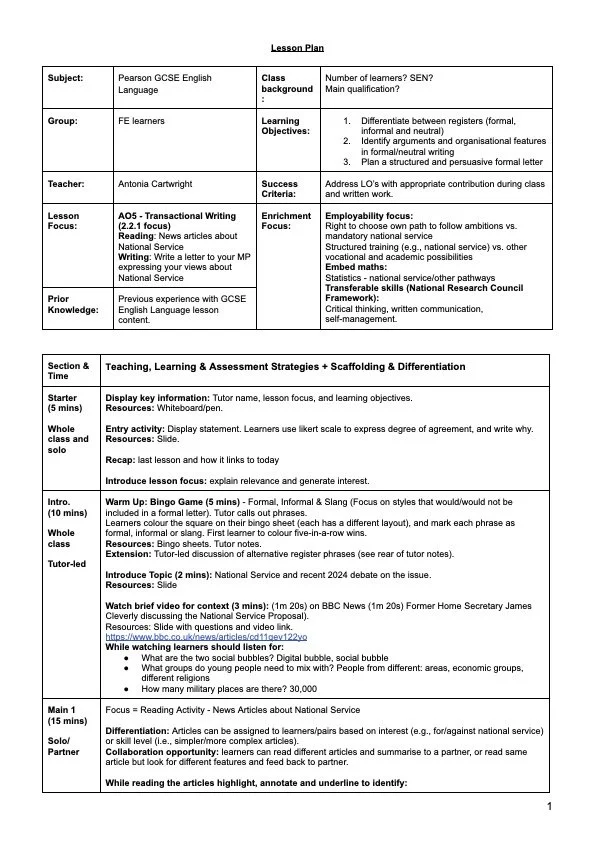GCSE English Resources for Teachers: Lesson Plan
This lesson plan focusses on transactional writing (AO5). It’s suitable for SEN learners and mixed GCSE/Functional Skills classes. It includes individual, pair and group activities and has opportunities for scaffolding and differentiation.
This lesson is engaging for learners and resulting in an excellent lesson observation write-up.Links to resources are included.
Plain text of the lesson plan is included below for your convenience, but feel free to download the GCSE English Language Lesson Plan PDF and adapt it to suit your needs.
Lesson Plan – GCSE English Language - Transactional Writing (PDF link above).
Teacher: Antonia Cartwright
Class background: FE learners. Number of learners and SEN needs to be specified.
Main qualification: GCSE English Language.
Lesson focus: AO5 – Transactional Writing (2.2.1 focus).
Reading: News articles about National Service.
Writing: Write a letter to your MP expressing your views about National Service.
Prior knowledge: Previous experience with GCSE English Language content.
Learning Objectives:
Differentiate between registers (formal, informal, and neutral).
Identify arguments and organisational features in formal/neutral writing.
Plan a structured and persuasive formal letter.
Success criteria: Address learning objectives with appropriate contributions during class and written work.
Enrichment focus:
Employability: right to choose own path to follow ambitions vs. mandatory national service.
Structured training (e.g., national service) vs. other vocational and academic possibilities.
Embed maths: statistics – national service/other pathways.
Transferable skills (National Research Council Framework): critical thinking, written communication, self-management.
Lesson Structure
Starter (5 mins, whole class and solo):
Display key information: tutor name, lesson focus, learning objectives. Entry activity: display statement; learners use a Likert scale to express agreement and explain why. Recap last lesson and link to today. Introduce lesson focus and relevance.
Resources: whiteboard, pen, slide.
Introduction (10 mins, whole class, tutor-led):
Warm-up (5 mins): Bingo game – identifying formal, informal, and slang registers. Learners mark phrases on bingo sheets; first to get five in a row wins. Extension: discussion of alternative register phrases.
Introduce topic: National Service and recent 2024 debate.
Watch BBC News video (1m 20s) of James Cleverly discussing National Service. Learners note: What are the two social bubbles? Which groups should young people mix with? How many military places are there?
Resources: bingo sheets, slides, tutor notes, video link.
Main 1 (15 mins, solo/partner):
Focus: reading news articles about National Service. Articles differentiated by complexity/stance. Learners highlight and annotate: organisational features, main ideas, linking words, examples of sentence types, and points for/against national service. Collaboration option: summarise to a partner.
Articles include: BBC article/simplified version, Conservatives.com, The Guardian, Breaking News English.
Main 2 (20 mins, solo, self-directed):
Focus: writing task – plan and/or write a letter to their MP about National Service. Learners start at different stages depending on ability (prepare, plan, or write). Task may continue next lesson. Extension: evaluate sample letters or write an article.
Resources: instruction sheet, glossary, review questions, points for/against list, coloured pens, template. Extension: peer review with focus on AO5 and AO6.
Review & Conclusion (10 mins, tutor-led):
Language registers gap fill as learning check.
Revisit initial prompt – have opinions changed?
Exit tickets: learner feedback on the lesson.
Signpost next lesson: continue letter writing, evaluate sample letters, write an article.
Resources: gap fill, post-its/note cards.
Resources
Google Slides
Bingo game
Language registers gap fill
BBC article and questions
Various articles on National Service
Writing cohesion word list
Letter template
Points for/against list
Tips for writing to MP (with college values)
Post-its for exit tickets
Lined paper, pens, highlighters
Homework
Look up your MP (name and address).
Complete final open-ended question from worksheet (personal/important issue to write to MP about).
Tutor Notes
British military branches: Army, Royal Navy (incl. Royal Marines), RAF.
Other forces: Special Forces (SAS, SBS), reserves, cadets.
Key definitions:
Tone: mood conveyed (formal, sarcastic, etc.).
Style: how writing is crafted (descriptive, persuasive, explanatory).
Register: level of formality.
Entry activity statement: “Too many young people are living in their own bubble. Young people need to mix more with people from different backgrounds.” Rate agreement (1–5) and explain why.
Article links:
https://www.conservatives.com/announcements/rishi-sunak-announces-national-service-policy
https://breakingnewsenglish.com/2405/240530-national-service.html
Glossary examples:
Mandatory: required by law.
Isolate: to set apart.
Practicality: quality of being practical.
Next lesson notes: develop peer review matrix for letter samples with focus on SPaG and AO6.
Functional Skills Levels and Reading Age
Grade Level for USA and UK (including GCSE)
·Entry Level 1
oReading Age: 5-7 years
oUK Grade Level: Key Stage 1 (Year 1-2)
oAmerican Grade Level: Kindergarten - 1st Grade
·Entry Level 2
oReading Age: 7-9 years
oUK Grade Level: Key Stage 2 (Year 3-4)
oAmerican Grade Level: 2nd - 3rd Grade
·Entry Level 3
oReading Age: 9-11 years
oUK Grade Level: Key Stage 2 (Year 5-6)
oAmerican Grade Level: 4th - 5th Grade
·Level 1
oReading Age: 12-14 years
oUK Grade Level: Key Stage 3 (Year 7-9)
oAmerican Grade Level: 6th - 8th Grade (Middle School)
·Level 2
oReading Age: 14-16 years
oUK Grade Level: Key Stage 4 (Year 10-11, similar to GCSE level)
oAmerican Grade Level: 9th - 10th Grade (High School)



